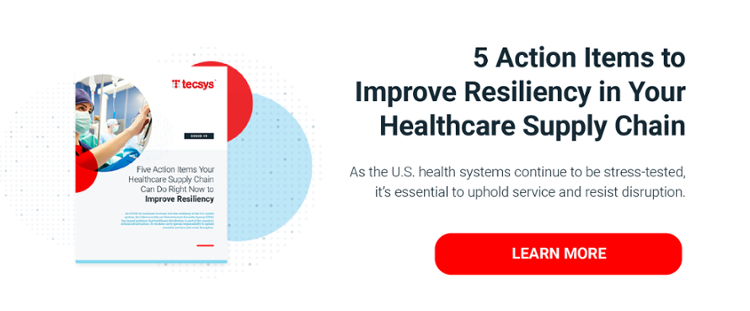3 Symptoms of an Unhealthy Healthcare Supply Chain Strategy

For many executives the COVID-19 pandemic revealed cracks, gaps, and in some cases chasms, in their healthcare supply chain strategy, with vast shortages of personal protective equipment (PPE) and other supplies. While it took a pandemic to highlight these issues, they have in fact been plaguing the industry for quite some time in terms of higher costs, vast inefficiencies and tremendous waste.
Healthcare supply chain leaders are now taking a critical look at their processes, technologies, suppliers and other partners to determine how they can improve resiliency, while delivering greater value at the same time. Based on our work with health systems and hospitals, we have seen common issues that have been exacerbated by the pandemic. Organizations that make improvements in these areas can not only address current challenges, but also position themselves for future success.
Three symptoms of an unhealthy healthcare supply chain strategy
1. Supply Chain in a Silo
For most organizations, supply chain is the individuals working behind the scenes to procure the products clinicians demand, ideally at a competitive price. Clinicians make clinical decisions with regards to products, and supply chain makes contractual and cost decisions, with supply chain constantly struggling to satisfy physician preference within shrinking supply budgets.
In recent years, payment reforms and the transition to value-based care have pushed healthcare organizations to scrutinize their second largest area of expense – supplies – and challenge supply chain leaders to transform their operations. Many have turned to supply standardization as a way to maintain care quality while reducing costs, but have quickly learned that this cannot occur in a silo.
It requires stakeholders from throughout a healthcare organization, most notably supply chain and clinicians, to come together in a collaborative way, leveraging a “clinically integrated supply chain” model through which they can make decisions that are best for the physical health of patients and the financial health of the organization.
2. Data Distrust
It isn’t lack of data that prevents good decision-making for a solid healthcare supply chain strategy, but rather the poor quality of that data, with most health systems and hospitals struggling with outdated, inaccurate and incomplete information on their supply purchases, management and utilization.
The last thing anyone wants is for a patient to be on the table with clinicians not having the supplies they need to provide care. Unfortunately, many healthcare organizations are still stuck in reactive supply chain management, where supply chain departments are constantly behind the eight ball to avoid supply shortages and stockouts with little or no visibility into true inventory levels throughout their facilities.
COVID-19 has highlighted the importance of proactive supply chain decision-making, but demand planning is only as valuable as the data backing it. Now is the time to take a hard look at the quality of supply chain data. Questions to ask include: Where is the data coming from, are these sources reliable, is the data accurate and complete, and is it timely enough to make meaningful decisions?
3. Tired Technology
Perhaps the area most exposed by the COVID-19 pandemic is the outdated supply chain technologies still used within health systems and hospitals today. When challenged to determine what COVID-19 critical supplies they had in inventory and in which locations, what supplies were in transit from distributors and suppliers, and what alternative products were in the marketplace to address those in short supply, many supply chain teams discovered a lack of visibility into and control over their operations.
Legacy supply chain platforms that are incapable of integration with other critical systems (e.g. EHR, financial systems) requiring manual intervention by supply chain and clinical staff alike are incapable of supporting today’s healthcare environment, not only during a pandemic, but also during business as usual.
When a healthcare organization cannot accurately and efficiently track inventory, capture product usage and manage replenishment processes, it risks clinicians not having the supplies they need to care for patients, wasted products/use of expired products and missed charge capture/lost revenue. Furthermore, manual supply chain interventions take clinician time away from their primary focus – the patient.
Implementation of technology platforms that automate supply chain processes and seamlessly integrate with connected systems increase visibility and control while decreasing costs, risks and waste. They provide leaders with a holistic approach to their healthcare supply chain strategy; one that helps to ensure product availability, keeps clinicians focused on patients and ultimately contributes to higher quality care at a lower cost. System integration and automation that minimizes manual intervention and the risk for human error also supports the generation of accurate, complete and timely data on which to make informed and proactive supply chain decisions.



